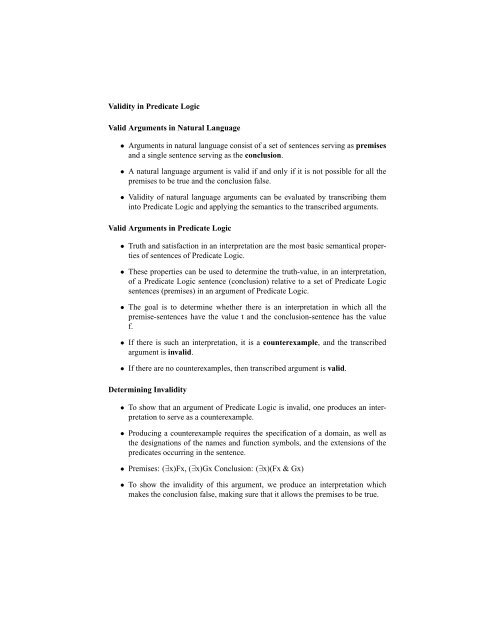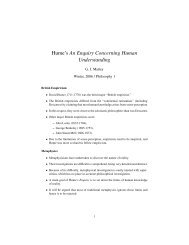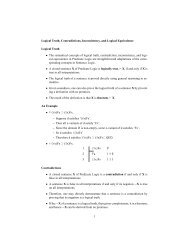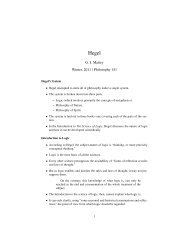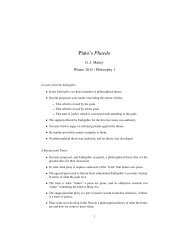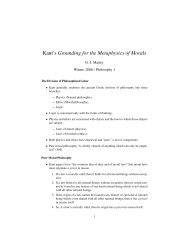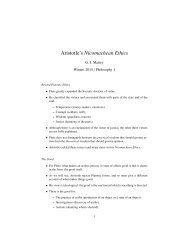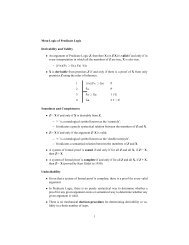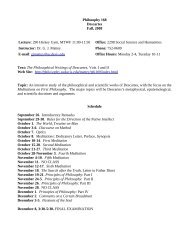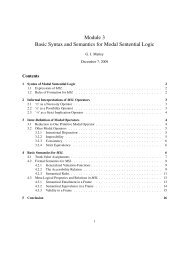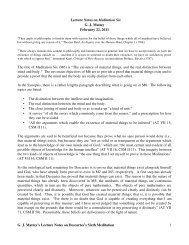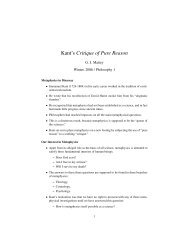Validity in Predicate Logic - the UC Davis Philosophy Department
Validity in Predicate Logic - the UC Davis Philosophy Department
Validity in Predicate Logic - the UC Davis Philosophy Department
You also want an ePaper? Increase the reach of your titles
YUMPU automatically turns print PDFs into web optimized ePapers that Google loves.
<strong>Validity</strong> <strong>in</strong> <strong>Predicate</strong> <strong>Logic</strong>Valid Arguments <strong>in</strong> Natural Language• Arguments <strong>in</strong> natural language consist of a set of sentences serv<strong>in</strong>g as premisesand a s<strong>in</strong>gle sentence serv<strong>in</strong>g as <strong>the</strong> conclusion.• A natural language argument is valid if and only if it is not possible for all <strong>the</strong>premises to be true and <strong>the</strong> conclusion false.• <strong>Validity</strong> of natural language arguments can be evaluated by transcrib<strong>in</strong>g <strong>the</strong>m<strong>in</strong>to <strong>Predicate</strong> <strong>Logic</strong> and apply<strong>in</strong>g <strong>the</strong> semantics to <strong>the</strong> transcribed arguments.Valid Arguments <strong>in</strong> <strong>Predicate</strong> <strong>Logic</strong>• Truth and satisfaction <strong>in</strong> an <strong>in</strong>terpretation are <strong>the</strong> most basic semantical propertiesof sentences of <strong>Predicate</strong> <strong>Logic</strong>.• These properties can be used to determ<strong>in</strong>e <strong>the</strong> truth-value, <strong>in</strong> an <strong>in</strong>terpretation,of a <strong>Predicate</strong> <strong>Logic</strong> sentence (conclusion) relative to a set of <strong>Predicate</strong> <strong>Logic</strong>sentences (premises) <strong>in</strong> an argument of <strong>Predicate</strong> <strong>Logic</strong>.• The goal is to determ<strong>in</strong>e whe<strong>the</strong>r <strong>the</strong>re is an <strong>in</strong>terpretation <strong>in</strong> which all <strong>the</strong>premise-sentences have <strong>the</strong> value t and <strong>the</strong> conclusion-sentence has <strong>the</strong> valuef.• If <strong>the</strong>re is such an <strong>in</strong>terpretation, it is a counterexample, and <strong>the</strong> transcribedargument is <strong>in</strong>valid.• If <strong>the</strong>re are no counterexamples, <strong>the</strong>n transcribed argument is valid.Determ<strong>in</strong><strong>in</strong>g Invalidity• To show that an argument of <strong>Predicate</strong> <strong>Logic</strong> is <strong>in</strong>valid, one produces an <strong>in</strong>terpretationto serve as a counterexample.• Produc<strong>in</strong>g a counterexample requires <strong>the</strong> specification of a doma<strong>in</strong>, as well as<strong>the</strong> designations of <strong>the</strong> names and function symbols, and <strong>the</strong> extensions of <strong>the</strong>predicates occurr<strong>in</strong>g <strong>in</strong> <strong>the</strong> sentence.• Premises: (∃x)Fx, (∃x)Gx Conclusion: (∃x)(Fx & Gx)• To show <strong>the</strong> <strong>in</strong>validity of this argument, we produce an <strong>in</strong>terpretation whichmakes <strong>the</strong> conclusion false, mak<strong>in</strong>g sure that it allows <strong>the</strong> premises to be true.
An Example• D = {1, 2}, v(F) = {〈1〉}, v(G) = {〈2〉}• No variable assignment to ‘x’ satisfies both ‘Fx’ and ‘Gx’, and so none satisfies‘Fx & Gx’, so ‘(∃x)(Fx & Gx)’ is false.• d[1/x] satisfies ‘Fx’, so any d satisfies ‘(∃x)Fx• d[2/x] satisfies ‘Gx’, so any d satisfies ‘(∃x)Gx’; so, both premises are true.• So on this <strong>in</strong>terpretation, <strong>the</strong> premises are true and <strong>the</strong> conclusion false, whichdemonstrates <strong>the</strong> <strong>in</strong>validity of <strong>the</strong> argument.Determ<strong>in</strong><strong>in</strong>g <strong>Validity</strong>• Because validity of arguments is def<strong>in</strong>ed <strong>in</strong> terms of all possible <strong>in</strong>terpretations,it cannot be proved on <strong>the</strong> basis of a s<strong>in</strong>gle <strong>in</strong>terpretation.• General reason<strong>in</strong>g about <strong>in</strong>terpretations is required.• For this reason, we use metavariables to <strong>in</strong>dicate arbitrary:– Interpretations I– Doma<strong>in</strong>s D– Objects <strong>in</strong> <strong>the</strong> doma<strong>in</strong> u (with or without positive <strong>in</strong>teger subscripts)– Valuation functions v• At this level of generality, we can still draw conclusions about what must hold if<strong>the</strong> premises of an argument are to be true <strong>in</strong> an arbitrary <strong>in</strong>terpretation.An Example• To prove: {(∀x)(Fx ⊃ Gx), Fa} Ga• Let I be an arbitrary <strong>in</strong>terpretation, v a valuation function <strong>in</strong> I, and d an arbitraryvariable assignment.• Suppose that ‘(∀x)(Fx ⊃ Gx)’ and ‘Fa’ are true <strong>in</strong> I.• Let v(a) = u 1• Then for all u <strong>in</strong> <strong>the</strong> doma<strong>in</strong> D of I, d[u/x] satisfies ‘Fx ⊃ Gx’.• Because d satisfies ‘Fa’, 〈v(a)〉 ∈ v(F), so 〈u 1 〉 ∈ v(F).• Then d[u 1 /x] satisfies ‘Fx’, so d[u 1 /x] satisfies ‘Gx.’• It follows that 〈u 1 〉 ∈ v(G), so 〈v(a)〉 ∈ v(G).• Then d satisfies ‘Ga’, which is thus true <strong>in</strong> I, QED.2


